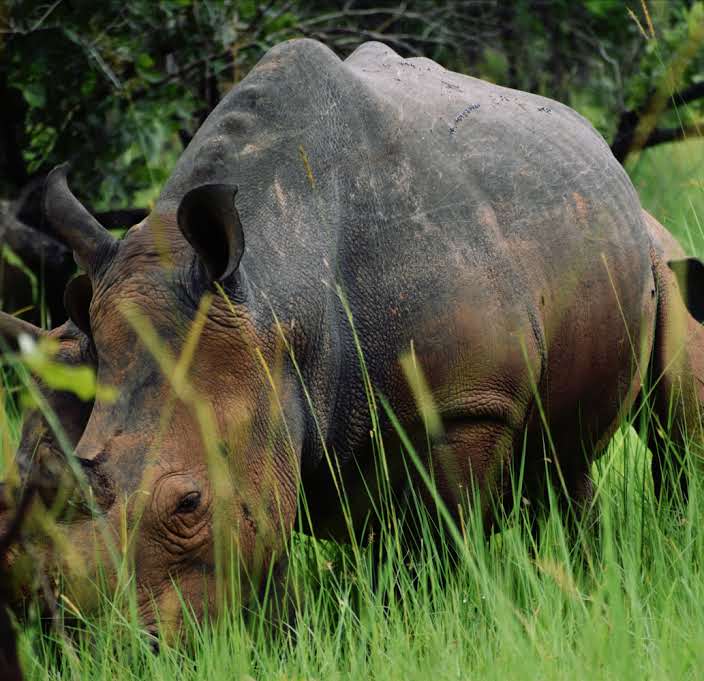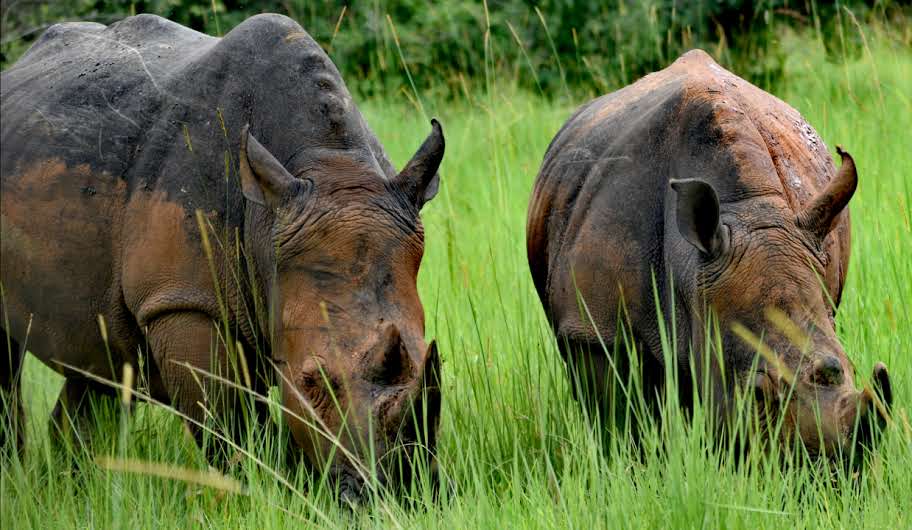- EXPERT'S HELP
- +256789210067
- +256200955001
- info@kenlinktours.com

Where to see the big five Mammals in Uganda
September 25, 2023
Activities in Bwindi National Park.
September 25, 2023Uganda is home to both white and black rhinoceros populations. Here’s some information about rhinos in Uganda:
Rhino Species: There are two main species of rhinoceros in Uganda:
White Rhinoceros (Ceratotherium simum): Uganda is home to the southern white rhinoceros population. These rhinos are mainly found in the Ziwa Rhino Sanctuary.
Black Rhinoceros (Diceros bicornis): The black rhinoceros population in Uganda has been historically small, and they are primarily found in national parks and protected areas.
Ziwa Rhino Sanctuary: Located in Nakasongola district in central Uganda, the Ziwa Rhino Sanctuary is the primary conservation area for rhinos in the country. It was established in 2005 with the goal of reintroducing rhinos to Uganda after they were extirpated (locally extinct) due to poaching in the early 1980s. The sanctuary is home to a growing population of southern white rhinos and is open to tourists who can go on guided rhino tracking safaris.
Conservation Efforts: The Uganda Wildlife Authority (UWA) and several conservation organizations have been working together to protect and conserve rhinos in Uganda. This includes anti-poaching efforts, habitat restoration, and monitoring of rhino populations.
Challenges: Rhinos in Uganda, like in many other parts of Africa, face threats from poaching for their horns, habitat loss due to human encroachment, and conflicts with local communities. Conservation efforts have made progress in addressing these threats, but continued vigilance and support are needed to ensure the survival of these iconic animals.
Tourism: Rhino tracking has become a popular tourist activity in Uganda, attracting visitors who want to see these magnificent creatures up close while contributing to their conservation efforts.

When is the best time to see Rhinos
The best time to see rhinos in Uganda, particularly in the Ziwa Rhino Sanctuary, can depend on various factors, including the weather and your personal preferences for wildlife viewing. Here are some considerations to help you plan your visit:
- Dry Season: Like many other wildlife species, rhinos in Uganda are often more accessible during the dry season. The dry season typically runs from December to February and from June to August. During this time, vegetation is less dense, and animals, including rhinos, tend to gather around water sources, making them easier to spot.
- Early Morning and Late Afternoon: Rhinos are generally more active during the cooler parts of the day, which are early in the morning and late in the afternoon. Going on a rhino tracking safari during these times can increase your chances of spotting them.
- Avoiding Extreme Heat: Rhinos may seek shade and rest during the hottest parts of the day, which can make them less visible. Therefore, it’s often better to plan your visit when temperatures are milder.
- Rainy Season: While the rainy season (March to May and September to November) can be less crowded with tourists, it can also be more challenging for wildlife viewing. Rain can make dirt roads muddy and impassable, and the lush vegetation can provide more cover for animals. However, some travelers prefer the lower visitor numbers and the opportunity to see the landscape in its vibrant, green state.
- Consult with Local Guides: To maximize your chances of seeing rhinos, it’s a good idea to consult with local guides or the staff at the sanctuary you plan to visit. They have up-to-date information on rhino movements and can provide guidance on the best times for rhino tracking.
- Consider Multiple Days: Rhinos are not always easy to spot in the wild, even in well-managed sanctuaries. Consider staying for multiple days if your schedule allows, as this gives you more opportunities to see these incredible creatures.
How much is Rhino Tracking in Uganda
- How much Rhino is depends on how long the safari is, how many you are and what other activities you will be doing on that safari. Since rhinos are part of the big five mammals, one would love to see more other big mammals like Lions, Leopards, Elephants and Buffaloes. Rhino tracking in Ziwa Rhino sanctuary can be combined with Murchison falls national park and this can be done on a 3-4 days safari. Such a safari can cost you from $800 per person full board, depending on the number of people. This trip can give you a chance to see the big five mammals.
- Ziwa Rhino Sanctuary: Ziwa Rhino Sanctuary is one of the most popular destinations for rhino tracking in Uganda. As of my last update, the cost for rhino tracking at Ziwa Rhino Sanctuary typically ranged from around $40 to $50 USD per person for foreign tourists. This fee often includes a guided tour, and the proceeds go toward rhino conservation efforts.
- Additional Fees: In some cases, there may be additional fees for park entrance, conservation, or camera permits. These fees can vary depending on the specific policies of the sanctuary or national park you visit.
- Guided Tours: Rhino tracking is typically conducted as a guided activity to ensure visitor safety and minimize disturbance to the rhinos. The cost of a guided tour is usually included in the overall tracking fee.
Below is a Sample of a 4 Days Big five safari that covers Rhino Tracking.
A 4-day Big Five safari in Uganda is an exciting adventure that allows you to see some of Africa’s iconic wildlife species, including the lion, elephant, buffalo, leopard, and rhinoceros. While Uganda is not as renowned for its Big Five safaris as some other African countries, it does offer opportunities to see these magnificent animals in various national parks and wildlife reserves. Here’s a sample itinerary for a 4-day Big Five safari in Uganda:

Day 1: Arrival in Entebbe
- Arrive at Entebbe International Airport.
- Transfer to your accommodation in Entebbe.
- Relax and prepare for your safari adventure.
Day 2: Drive to Murchison Falls National Park
- Early morning breakfast.
- Depart for Murchison Falls National Park, one of Uganda’s premier wildlife destinations.
- Stop at Ziwa Rhino Sanctuary for a rhino tracking experience (to see the southern white rhino).
- Continue the journey to Murchison Falls National Park.
- Check in at your lodge for dinner and overnight.
Day 3: Game Drive and Boat Safari
- Early morning game drive in the northern sector of the park.
- Look out for lions, elephants, buffalos, giraffes, and various antelope species.
- Return to the lodge for lunch and relaxation.
- In the afternoon, take a boat safari on the Nile River to the base of Murchison Falls.
- View hippos, crocodiles, and numerous bird species.
- Return to the lodge for dinner and overnight.
Day 4: Game Drive and Return to Entebbe
- Another early morning game drive in a different section of the park.
- Search for leopards, lions, and other wildlife.
- Return to the lodge for breakfast.
- Check out and begin your journey back to Entebbe.
- Depending on your flight schedule, you may have time for a visit to the top of Murchison Falls.
- Arrive in Entebbe in the evening for your departure or overnight stay.
Get a Full Quote.

Error: Contact form not found.




